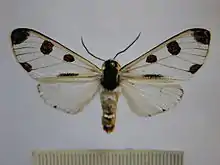Dysschema boisduvalii
Dysschema boisduvalii is a moth of the family Erebidae first described by Jan van der Hoeven in 1840. It is found in Paraguay, Colombia, Brazil[1] and Argentina.[2]
| Dysschema boisduvalii | |
|---|---|
 | |
| Scientific classification | |
| Kingdom: | |
| Phylum: | |
| Class: | |
| Order: | |
| Family: | |
| Genus: | |
| Species: | D. boisduvalii |
| Binomial name | |
| Dysschema boisduvalii (Hoeven, 1840) | |
| Synonyms | |
| |
Adults are sexually dimorphic. Males are white with four blackish dots on the forewings, while females are mostly blackish with the dots on the abdomen reduced.
The larvae feed on the leaves of Vernonia species.
References
- Savela, Markku. "Dysschema boisduvallii (van der Hoeven, 1840)". Lepidoptera and Some Other Life Forms. Retrieved September 5, 2019.
- Becker, Vitor O. (15 September 2013). "Taxonomic changes in the Neotropical Pericopina and Ctenuchina moths (Erebidae, Arctiinae, Arctiini), with description of new taxa" (PDF). The Journal of Research on the Lepidoptera. 46: 53–66. Archived from the original (PDF) on December 24, 2013.
| Wikimedia Commons has media related to Dysschema boisduvalii. |
| Wikispecies has information related to Dysschema boisduvalii. |
This article is issued from Wikipedia. The text is licensed under Creative Commons - Attribution - Sharealike. Additional terms may apply for the media files.